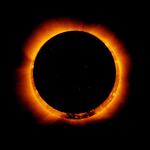
An annular eclipse.
NASA Goodard Space Flight Center
For the first time since 1994, a partial solar eclipse will be visible across the Northwest. In most parts of the region, the eclipse will look like the moon taking a big bite out of the sun, but Southern Oregon lies directly in the path of the moon’s shadow. South of Grants Pass, viewers will see the moon block the sun, leaving only a ring of light, or annulus, visible.
In Southern Oregon, the eclipse will reach its peak, blocking about 87 percent of the sun, at 6:24 Sunday night. In Portland and Seattle, the eclipse will peak at roughly 6:20 p.m.
Jim Todd directs the planetarium at the Oregon Museum of Science and Industry. Todd watched his first eclipse in February 1979; he had to sneak out of a high school science class to see it. Here are his suggestions for how you can safely observe the eclipse on Sunday.
Wherever you are, make sure the western horizon is visible. Do not look directly at the eclipse without protection; UV light from the sun can permanently damage your eyes.
1. Find a viewing party: Science museums and astronomy clubs across the region are hosting parties, and will have solar glasses and telescopes with special filters to allow for safe viewing. OMSI is hosting a party in Portland and the Southern Oregon Skywatchers and ScienceWorks Museum will throw a party in Ashland.
2. Buy a pair of solar viewing glasses -- available at OMSI in Portland and at the Pacific Science Center Store in Seattle. You could order a pair from amazon.com, and if they don't arrive in time for Sunday's viewing, save them for 2017 -- or even next month (see below).
3. Binoculars: Set a pair of binoculars up on a tripod, and point them toward the sun, being careful not to look at the sun yourself. Hold a piece of paper behind the binoculars, and an image of the sun will appear projected on it. Here's a helpful video.
4. Stand under a leafy tree: The tree essentially functions as a giant pinhole projector. If you look at the ground, you will see an image of the sun and the moon projected underneath the tree.
5. Straw hat: like the tree, a straw hat with tiny holes in it can also project an image on the ground. Stand with your back to the sun, hold up the hat behind you, and look for the image on the ground.
6. Skype: Todd says he's heard lots of people will be sharing real-time images of the eclipse with family and friends over skype. If it's too cloudy for a good view in your neighborhood, log on and find someone willing to share their eclipse experience.
Hang on to your solar viewing glasses. On June 6th, the planet Venus will be visible passing in front of the sun. Watching the transit of Venus is a truly once in a lifetime experience -- it won’t happen again for over 100 years.
Directly underneath the 200 mile wide path of the moon's shadow, a "ring of fire" or annular eclipse will be visible. Credit: NASA Goodard Space Flight Center.


